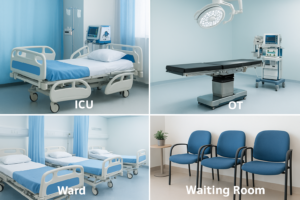
“Operation Theater Construction & Renovation Services”
- Introduction
- Importance of proper operation theater (OT) construction and renovation
- Overview of the healthcare infrastructure needs
- The Role of Well-Designed Operation Theaters
- Impact on surgical outcomes and patient safety
- Benefits of efficient OT layout and design
- Components of Operation Theater Construction
- Layout and space planning
- Structural requirements for stability and durability
- Specialized flooring and wall materials
- Key Aspects of Operation Theater Renovation
- Upgrading equipment and technology
- Enhancing ventilation and sterilization systems
- Redesigning for optimized space usage
- Sterilization and Infection Control in OT Design
- Importance of sterile surfaces and materials
- Infection control features to integrate in design
- Importance of Proper Lighting and HVAC Systems
- Role of lighting in precision surgeries
- HVAC systems for air quality and temperature control
- Selecting Materials for OT Construction
- Choosing durable, non-porous surfaces
- Recommendations for ceilings, walls, and flooring
- Technological Integration in Modern OTs
- Digital health solutions and data management
- Real-time monitoring and communication systems
- Case Studies: Successful OT Construction & Renovations
- Examples of hospitals with state-of-the-art OTs
- Lessons learned and best practices
- Government and Private Sector Role in OT Development
- Public sector initiatives for OT construction
- Private sector contributions and innovations
- Budgeting and Cost Considerations
- Budgeting for construction vs. renovation
- Tips for cost-effective upgrades
- Challenges in Operation Theater Construction and Renovation
- Regulatory compliance and standards
- Time and logistical constraints
- The Importance of Professional Expertise in OT Projects
- Role of architects, engineers, and healthcare consultants
- Ensuring alignment with healthcare regulations
- Future Trends in OT Design and Construction
- Smart technologies in OTs
- Trends toward eco-friendly and sustainable designs
- Conclusion
- Summary of the benefits of OT construction and renovation
- Call for continuous improvement in OT infrastructure
Operation Theater Construction & Renovation Services
Introduction
Operation theaters are critical spaces within hospitals, requiring precise design and continuous upgrades to meet evolving healthcare standards. Quality OT construction and renovation ensure that patients receive optimal care in a safe, sterile environment. The healthcare sector’s growing demand for modern, efficient operation theaters highlights the importance of innovative construction and renovation services.
The Role of Well-Designed Operation Theaters
A well-designed OT directly impacts surgical outcomes, enhances patient safety, and streamlines workflow for medical staff. Efficient OT layouts minimize movement and maximize space, allowing for smoother operations and faster response times. For both new constructions and renovations, focusing on design efficiency can yield long-term benefits.
Components of Operation Theater Construction
Constructing an operation theater involves several specialized considerations:
- Layout and Space Planning: Planning the OT layout is essential for optimizing space and workflow. It includes areas for surgical procedures, anesthesia, recovery, and equipment storage.
- Structural Requirements: Durable construction materials provide stability, particularly for OTs that house heavy machinery.
- Specialized Flooring and Wall Materials: Using non-porous materials helps maintain cleanliness and prevents bacterial growth, ensuring a sterile environment.
Key Aspects of Operation Theater Renovation
Renovation projects focus on enhancing existing OTs by updating equipment, improving ventilation, and redesigning spaces for better utilization. Renovations may include:
- Upgrading Equipment and Technology: Adding advanced surgical tools and imaging systems.
- Enhancing Ventilation and Sterilization Systems: Improving airflow helps maintain air quality, reducing the risk of contamination.
- Optimized Space Usage: Renovations often reorganize space, ensuring all necessary tools are within easy reach.
Sterilization and Infection Control in OT Design
Infection control is a top priority in OT construction and renovation. Sterile surfaces and design elements that reduce the risk of contamination are critical. Choosing materials that are easy to clean and implementing features like air filtration systems enhance the OT’s sterility.
Importance of Proper Lighting and HVAC Systems
Precise lighting is essential for surgical accuracy, reducing shadows, and ensuring visibility during procedures. HVAC systems control the temperature and air quality, keeping the environment comfortable and safe for both patients and medical staff.
Selecting Materials for OT Construction
Durable, non-porous materials are ideal for OTs to maintain cleanliness. Walls, ceilings, and floors should be resilient and resistant to moisture and bacteria. These materials ensure the OT remains sterile and reduce maintenance needs over time.
Technological Integration in Modern OTs
Modern OTs benefit from digital solutions such as Electronic Health Records (EHR) and real-time patient monitoring systems, which improve decision-making during surgeries. Integration of communication systems allows surgeons and support staff to collaborate more effectively.
Case Studies: Successful OT Construction & Renovations
Some hospitals have set benchmarks in OT design by implementing the latest technology and optimal layouts. For example, a recent renovation at a hospital in Islamabad introduced modular OTs with robotics and digital monitoring systems, resulting in faster recovery times and improved patient care. Such projects provide valuable insights into the benefits of thoughtful OT construction.
Government and Private Sector Role in OT Development
The government has introduced several initiatives aimed at improving healthcare infrastructure, including OT upgrades in public hospitals. The private sector complements these efforts with investments in advanced facilities, promoting the availability of high-quality healthcare.
Budgeting and Cost Considerations
Operation theater construction and renovation projects require detailed budgeting, balancing costs with quality. Renovations may be more affordable than new constructions, depending on the extent of the upgrades. A clear budget ensures that facilities can plan effectively without compromising on safety or quality.
Challenges in Operation Theater Construction and Renovation
Compliance with healthcare regulations and standards is crucial, and delays due to regulatory checks are common. Additionally, logistical challenges, such as managing construction in active hospital environments, require meticulous planning to avoid disrupting patient care.
The Importance of Professional Expertise in OT Projects
OT construction and renovation demand specialized skills from architects, engineers, and healthcare consultants. Professionals ensure that designs meet both functional and regulatory requirements, creating a safe and efficient space for healthcare providers and patients alike.
Future Trends in OT Design and Construction
Looking forward, trends in OT construction focus on smart technology, sustainability, and eco-friendly materials. Integrating smart lighting and temperature control systems, along with energy-efficient building materials, can make OTs more sustainable and responsive to future healthcare demands.
Conclusion
Investing in the construction and renovation of operation theaters is essential for improving healthcare services. Upgraded OTs equipped with modern technology, efficient layouts, and durable materials ensure that patients receive high-quality care in a safe environment. As healthcare needs grow, continuous improvements in OT infrastructure are vital for sustaining a robust healthcare system.




